John Duff, Timeline. 95 x 53 x 33 in. Photo by Sally Ross.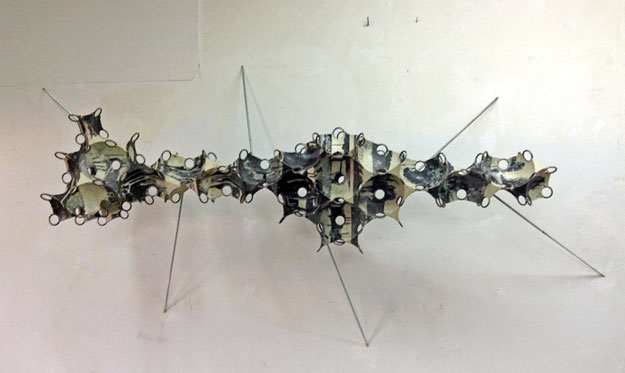
Elusive as it is, abstract art may nonetheless offer some clues for solving our conundrum. A refusal to distract with nature’s reflection may, after all, offer the advantage of an unfiltered view of the creative process. But first—what, exactly, is abstraction? As partial answer we might reflect that we are dealing with an absence, a lack of easily recognizable shapes. And we might posit we are dealing with a commonality, a phenomenon arising before our eyes as we identify forms common to a defined set. But can we achieve a more comprehensive understanding of the convoluted artifacts that artists have been labeling as “abstract” for the past century?
John Duff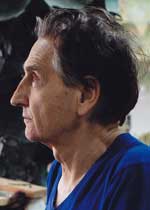
Duff denies the validity of any such approach to replicate the surface of natural objects. In speaking of traditional art Duff initially produced, during one of our numerous recent conversations, a rather slighting reference to the act of “tiptoeing through the tulips.” Thinking better of the matter at a later date, he defaulted to the citation of a quotation which he had jotted in his dog-eared notebook some time ago (The artist is a devoted quotation collector) and which he feels was his denigrating statement’s likely source. The following passage by Daniel Mendelsohn appeared in a New Yorker essay about the poet Arthur Rimbaud:
He suddenly saw that the true subject of a new poetry couldn’t be the usual things—landscapes, flowers, pretty girls, sunsets—but, rather, the way those things are refracted through one’s own unique mind.
Mendelsohn’s interpretation of Rimbaud's transformation of poetic language applies equally, maintains Duff, to his own work with the constructive materials of the plastic arts. His vigorous support for a dynamic in which the figurative has been supplanted by the immaterial suggests, for our journey here, a promising trail head. Let us attempt to blaze what Duff would identify as the true path—let us, that is, identify the principles which activate what Duff recognizes as the abstract imperative—and thereby obtain insights into the nature of our phenomenon.
The Kepler Conjecture
Duff’s work has long been informed by science and its examination of physical forces. Some years ago the artist was inspired by a story in a science periodical to plan the creation of a series of ceramic Penrose Tiles, named after the mathematician and physicist Roger Penrose. To better understand their nature Duff turned to Pierre Hohenberg, a longtime friend and Professor of Physics at New York University. Hohenberg visited Duff’s studio with a clutch of relevant academic papers. The result was a series of works constructed with what mathematicians call matching rules.
John Duff, Penrose Tiles. Various sizes.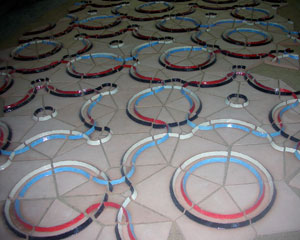
Shortly after completing Fractured Icosahedron Duff spotted an intriguing graphic in the catalog for a Buckminster Fuller show. “I was looking at this circle surrounded by six others,” recalls Duff. “And I thought to myself, ‘Those circles could be spheres.’” He shared his idea of sculpting such objects with another mathematician who informed Duff of a phenomenon called the Kepler conjecture. Advanced in the 17th century by Johannes Kepler, this hypothesis asserts that no arrangement of equally sized spheres can possess a greater fraction of space—that is, can result in a greater density– than the 74.04 percent achievable by two processes mathematicians call cubic and hexagonal close packing. Duff began to consider how the Kepler conjecture might be represented in a sculpture.
Again Hohenberg provided relevant papers, this time on the principles of the Kepler conjecture. After studying these Duff began a new construct by surrounding a single sphere with six others, the centers of which formed a hexagon. Upon the resulting platform he positioned a second layer of three spheres, and atop that layer positioned a single sphere. The result was a triangle, mirrored by a similar structure of spheres constructed beneath the initial layer. After inserting steel rings to eliminate the knife edge where the spheres touched, Duff filled the gaps between the spheres with urethane resin, retaining that material in place with diamond-shaped plywood barriers. “I realized the internal spaces communicated with each other,” says Duff. “I could see that if I blocked up the outside I would create a mold which could be cast.” And from there the final step: The removal of the spheres to leave free-standing resin. Once again, as in Fractured Icosahedron, Duff had transformed a mathematical theory’s “left over space” into a solid. Because the resin had filled the space Kepler conjectured could not be occupied by his imagined spheres, Duff called the work Inside the Kepler Conjecture. Over the ensuing years Duff has created a series of similar works and intends to continue exploring the Keplerian theme with variously sized spheres and sculptures. “It’s like any other topic,” he explains, “You keep discovering new things.”
The nature of abstraction
John Duff, Fractured Icosahedron. 33 x 33 in.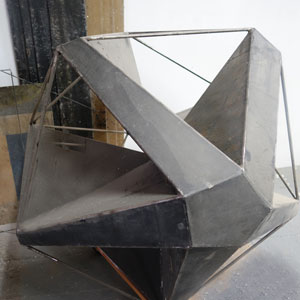
The artist attempts to match nature not only in process but in result: in the emanation of a beauty native to the materials of formation. “Nature is beautiful because of its absolute coherence,” says Duff. “It's coherent at a level we can't understand, but we know and accept it.” The artist likes to recall a story once old him by John Cage, who was in the habit of admiring the view of a lake-bound island visible through the Black Mountain College cafeteria window. The island was devoid of vegetation save for the existence of one lonely tree. One day Cage began to enthuse about the natural beauty of the island, prompting a nearby librarian to respond with these words: “It’s beautiful. But there’s only one thing wrong.” She pointed to the island's solitary inhabitant. “That tree is in the wrong place.”
This comment caused gales of merriment to burst from Cage, a fellow known for an infectious laugh. “For John Cage to be giving that uproarious laugh meant this whole Cage-an thing,” says Duff. “He had an Asian or Oriental point of view in believing that nature is perfect as it is—that nature’s way is the right way—and for him it was uproariously funny to think that the scene was perfect except that one tree was in the wrong place.”
The librarian in the above story was upholding the Western point of view—one that is alien to Duff and his colleagues. For Duff, the artist who successfully emulates nature’s activity will of necessity create beauty. If the abstract artist’s imitation of the natural process results in a beauty which is unconventional—and that is a word we commonly apply to abstract art—is this too not unlike nature? We look at a rough patch of woodland and recognize it as beautiful despite its violation of the conventional rules of art, for even what was historically referred to as the “sublime” was in its riot of natural confusion beauty’s twin.
As nature, so the artist. In leaving only what is requisite to his artifact, in operating at what he calls “the level of necessity,” in imitating, in other words, the processes of nature, Duff manifests a similar state of beauty. Here Duff speaks in such terms about his goal in creating The Kepler Conjecture:
"I knew if I could create an artifact that contains an arithmetic order, I wouldn’t have to trouble myself about trying to make it beautiful. A work in a perfectly attuned state of coherence and interdependence and necessity is ipso facto a beautiful mathematical object."
The creation of such beauty, organic to and emanating from a refined process conducted at the level of necessity, stands in sharp contrast to the results of any conscious attempt to impress upon constructive materials the rules of art. Duff puts it this way: “To try to make your work on the level of beauty is to miss the point."
John Duff, Inside the Kepler Conjecture. 21 1/4 in. vert x 12 1/2 in. horiz. Photo by Sally Ross.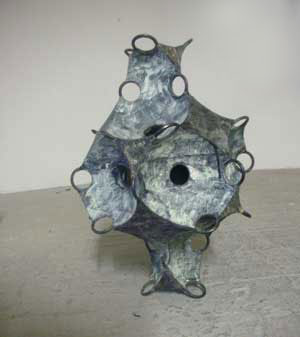
"Beauty was a purely incidental result, not consciously brought about by any thought of it in engineers and builders faced with problems of terrific difficulty, but only by the curious agreement there exists in the nature of things between an admirably utilitarian creation and non-utilitarian beauty” (156-157).
Duff’s devotion to organic creation arises from a deeply held conviction, a morality of the real, an Eastern faith in fecund nature as template for human engagement. The artist rejects the Western condemnation of earthly imperfection and its attendant search for rightness in a higher world. Such notions, maintains Duff, arise from the father of the theory of forms, and it is the Platonic advance of ideals divorced from nature that is responsible for the “false path” down which humanity has marched for millennia, stamping upon the planet’s face a damaging impress. This Western devotion to detached ideals, says Duff, has tarnished the atelier where traditional and semi-abstract artists engage in a top-down imposition of cognitive images upon constructive materials. He expresses this philosophy in the following passage from his diary:
"In Edith Hamilton’s theory of utility I include nature, the ultimate utilization of resources, attributes, and materiality; this notwithstanding Plato’s theory of forms (imperfect Earth; perfection in some other realm), a thought with consequences we know all too well. To work on the level of necessity as in nature is to ‘imitate nature in its manner of operation.’ This is unlike representative art, a totally different way of receiving and possessing information which approaches in impossibility the relationship of nature to human nature.
"Certain religions embrace this divide. Some do not, and consider the highest state to be reintegration with nature. I am of the latter cast of mind and not being an adept perhaps the best I can do (all I can do) is point in that direction, indicate the levels and the parameters of my engagement. To engage with sculpture ‘in the manner of its (nature’s) operation’ is to be moving in the same area, the same field, as science, hence the reciprocal flow of content. The struggle (or dance) between nature and human nature is the motive force of the work, or, as Marx said, ‘the effort that goes into the work is recorded in the work.’"
As the above passage suggests, Duff’s deeply held philosophical convictions explain his fascination with science, and indeed his patterning of artistic creation upon scientific methods. The two disciplines, after all, engage with the world in a similar way, attempting to create value by isolating and delineating the forces of nature. The disciplines are similar as well in result, for sculpture and theoretical construct are both artifacts shaped from earth by human hand.
A sensitivity to the invisible natural hand, so requisite to the creation of organic beauty and so often lost to human beings, can be observed constantly in animals. In a conversation some years ago with Arthur C. Danto, Duff related an experiment in which human beings were discovered to respond subconsciously to changes introduced in a computer program. Danto’s response–"Even a bug could do that”–has stuck with Duff. “That’s the level I want my work to operate on,” he says. “What a bug can do.” He explains the process in these terms: “You don’t know what it is, exactly, that is getting around you. But your mind is reacting like the bug mind.” Duff is not bothered by this dynamic’s apparent lack of rational analysis. “Bug consciousness is great with me,” he says. “It’s higher consciousness, probably.” When human beings lose this higher consciousness they become capable of making something ugly. “If something's incoherent, which is often the case with something which is man-made, it can be ugly,” says Duff. “Man is the only creature that is capable of creating ugliness.”
These comments suggest a related question: If the successful artist becomes one with nature, reacting to her principles like a bug, why is it that bugs themselves and other animals do not create art? “They're in a perfect position because they haven't been kicked out of the garden,” maintains Duff. “They don't need to create art, right? Art is our never ending search for getting back. Why else? We're trying to present a vision of what we think is coherence.”
The first lever of meaning
John Duff, Pillar of Salt. 81 1/2 x 38 x 38 in. Photo by Sally Ross.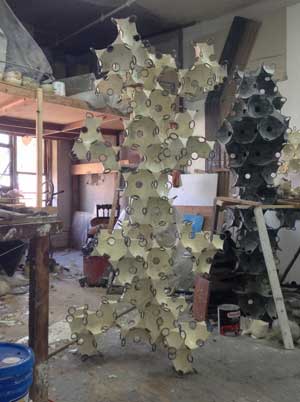
But what, to restate our larger question, does the abstract work of art mean? The question presents two concepts, and if we have reached a certain understanding of abstraction it remains to subject meaning to analysis. Suppose we begin by extending the well-known assertion of Wittgenstein: “The meaning of a word is in its use in the language.” This cryptic statement is itself open to interpretation. One way of appreciating its significance is to reflect upon the common employment of words. Consider this scenario:
Sam says “I want a desk.” He thinks of the word “desk” as a signifier of a natural object: a wooden artifact in the shape if an upside-down “U.” Lew, a carpenter, agrees to build Sam his desk, and creates a standing desk, an object with a physical appearance grossly dissimilar from Sam’s mental conception. At first Sam is upset, but once he tries out his new possession he is pleased. He tells Lew: “This is the best desk I ever had!”
Note that Sam used the word “desk” twice, and in neither case did it perform the function of signifying an inverted U-shaped wooden object. In neither instance did that object exist. Instead, the word signified a number of principles that in set produce a desired physical condition. One principle, for example, is a force holding up paper in a flat position. Another is a force allowing for storage of pencils. Furthermore, consider that Sam could have impelled the same result by pointing to an office corner and exclaiming “Desk!” One concludes, then, that the meaning of the word “desk” is what it does: the conjuring of a desired set of natural principles. It is only as a mental accommodation that Sam considers the word “desk” in the significant sense as a conventional piece of furniture in the shape of an inverted U.
Now suppose we consider language as a proxy for all media employed by creative artists, whether sculpture, oils or water colors. If this leads us to consider the meaning of a work of art as what it does, we must ask What does a work of art do? We have already seen that part of the answer is the engagement of artist with constructive materials. Suppose we specify this dynamic as the first lever of meaning. Yet just as Sam’s desk did not perform its intended activity until a user had performed a cooperative act, so can we say that the work of art does nothing until it obtains, through another party, a supportive effort.
The second lever of meaning
John Duff, Dust Devil. 55 1/4 in vert x 19 in deep.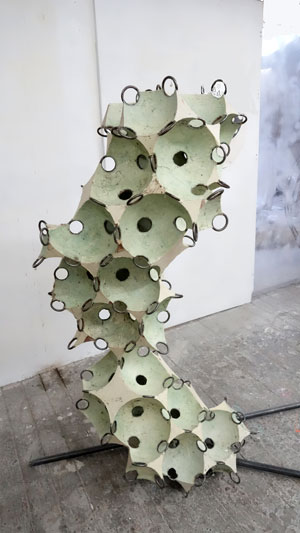
"There is nothing to the work but a simple piece of metal, cut away in different directions at both ends. The rest is in the mind of the viewer. In a way, the object exists for the mental twist that transforms it into sculpture" (3-4).
"The work draws for its being on attributes of the viewer, and on what must take place in the viewer’s mind for the work to come together as a synthesized whole" (14).
Danto noted that what occurs in the skilled viewer’s mind might be described as a “mental thing” or a cosa mentale, which is a title Duff has given one of his works. The term might also be translated as “mind matter” or something abstract that plays with the mind. However, this cosa mentale does not come into existence every time a work of art is seen. Viewers must prepare themselves for productive engagement. Success requires a sensitivity to the forces rendered in the work, skill in the engagement of the constructive materials, and knowledge of the observer’s creative role. When those factors come together the ambitious viewer engages the second lever of meaning.
At this point we can posit a complete answer to this article’s earlier question: What is the meaning of abstract art? We conclude that abstract art’s meaning is the aesthetic mechanism activated when artist and viewer simultaneously engage their respective levers upon an artifact’s constructive materials. The resulting dance of artist, artifact and audience causes the aesthetic machine to “work” and the germinal theory pops into view.
This triangular dialog is the meaning of all art, including the Mona Lisa mentioned at the top of this article. The meaning of a representational or semi-abstract work is no more a statement about a recognizable object than a poem’s meaning is a consideration of its significant language. If the recognizable forms characteristic of traditional art serve as invitations to the creative dance, they may also pull viewers away from the main current of the creative stream. It is partly to avoid this risk that many artists substitute the rigor of abstraction for the charm of representation. Engage the levers of the artistic machine, they call to us. Join our dialog.
Story by Walter Idlewild.
Posted July 23, 2015
Works Cited
Conway, J.H., and Torquato, S. Packing, Tiling, and Covering with Tetrahedra. PNAS Vol. 103 no. 28. July 11, 2006. 10612-10617.
Danto, Arthur C. John Duff: Elements, Increments, Intervals. Catalog for exhibition at Knoedler & Co. and Baumgartner Gallery. 2001.
Hamilton, Edith. The Roman Way. New York: W. W. Norton. 1932.
Mendelsohn, Daniel. Rebel Rebel: Arthur Rimbaud’s brief career. The New Yorker, August 29, 2011.
Unattributed statements by John Duff were recorded during a series of interviews with Walter Idlewild in the spring and summer of 2015.

